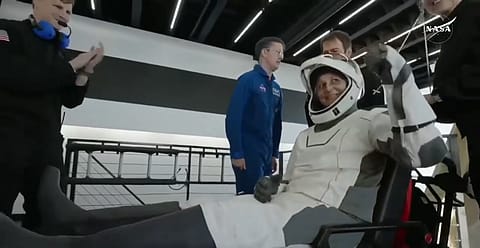Sunita Williams defies the odds: Inside her dramatic return to Earth after 9 months in space
Sunita Williams and Butch Wilmore waved and smiled as they emerged from the capsule.

NASA astronauts Sunita Williams and Butch Wilmore returned to Earth after nearly nine months aboard the International Space Station (ISS). They, along with NASA astronaut Nick Hague and Russian cosmonaut Aleksandr Gorbunov, were part of the SpaceX Crew-9 mission.
At 1:05 a.m. EDT (10:35 AM) Tuesday, NASA astronauts Nick Hague, Suni Williams, and Butch Wilmore, along with Roscosmos cosmonaut Aleksandr Gorbunov undocked from the space-facing port of International Space Station’s Harmony module aboard the SpaceX Dragon spacecraft. The splashdown took 17 hours.
The SpaceX Dragon spacecraft successfully splashed down off the coast of Florida at 5:57 PM EDT (3:27 AM IST.) Sunita Williams and Butch Wilmore waved and smiled as they emerged from the capsule, which was briefly inspected by a pod of dolphins as it bobbed in the ocean, awaiting retrieval by the rescue ship. During their time aboard the ISS, the duo conducted 150 experiments and logged 900 hours of research.
Reportedly, the per-seat cost of SpaceX’s Crew Dragon is around $55 million, significantly lower than Boeing’s Starliner.
Why were Sunita Williams and B. Wilmore delayed in arrival?
Williams and Wilmore were initially set for an eight-day mission aboard the Boeing Starliner in June 2024. However, technical issues forced their spacecraft to return without them, extending their stay unexpectedly.
Despite the delay, they remained active ISS crew members, conducting research, repairing equipment, and completing a spacewalk. Williams, who took over as station commander three months in, set a record for most spacewalking hours by a female astronaut—62 hours and 6 minutes over nine spacewalks.
Recommended Stories
How would have Williams and Wilmore struggled with extended space time?
Spending extended time in space triggers significant physiological and psychological changes. Microgravity weakens muscles, especially in the back, neck, and legs, with muscle mass dropping up to 30% over long missions. The spine elongates, making astronauts taller but increasing the risk of back pain and spinal injuries. Fluid shifts in microgravity raise pressure on the brain and eyes, potentially leading to vision problems, some of which may be permanent. The brain’s balance system is also affected, causing motion sickness, disorientation, and difficulty walking after return. The heart shrinks due to reduced workload, which can impact circulation and increase the risk of heart disease. DNA changes, including telomere shortening and radiation-induced damage, raise concerns about long-term health risks, including cancer. Astronauts in space face radiation levels up to 100 times higher than on Earth, comparable to thousands of chest X-rays. To counteract these effects, astronauts follow strict exercise routines, but deep-space missions pose even greater health challenges.
How is Sunita Williams related to India?
Williams, born in Ohio, has a paternal side based out of Jhulasan, Gujarat and a maternal side of Slovene descent. A retired U.S. Navy officer who also served in combat support roles during Operations Desert Shield and Provide Comfort in the Persian Gulf. Williams joined NASA in 1998. She has completed three missions to the International Space Station (ISS), accumulating over 321 days in space. Williams currently shares her house in Texas with her husband, Michael J. Williams, and their dogs, sharing a passion for working on houses, cars, and airplanes.
(INR CR)
How did the return happen?
Here’s a lowdown on the critical phases of SpaceX's Crew Dragon to ensure the safe return of astronauts to Earth:
Deorbit Burn: The spacecraft's engines fire in the opposite direction of its orbit, reducing its velocity and allowing Earth's gravity to pull it back. This manoeuvre is precisely timed to guide the capsule toward its designated landing site.
Capsule Separation: Prior to re-entry, the spacecraft jettisons unnecessary modules, such as the service module containing fuel and power systems, leaving only the crew module to continue the descent.
Atmospheric Re-Entry: The spacecraft enters Earth's atmosphere at speeds as high as 28,800 km/h (17,900 mph), generating intense friction and temperatures. Heat shields protect the crew by absorbing and dissipating this extreme heat. Astronauts experience G-forces up to five times Earth's gravity during this phase.
Parachute Deployment: As the capsule decelerates, small stabilising drogue chutes deploy first, followed by larger main parachutes, further reducing its descent speed to ensure a controlled landing.
Splashdown: For missions like those of SpaceX's Crew Dragon, the capsule lands in the ocean, where water provides a cushioned impact. Recovery teams, often from the U.S. Navy or Coast Guard, promptly retrieve the spacecraft and assist the astronauts as they readjust to Earth's gravity.